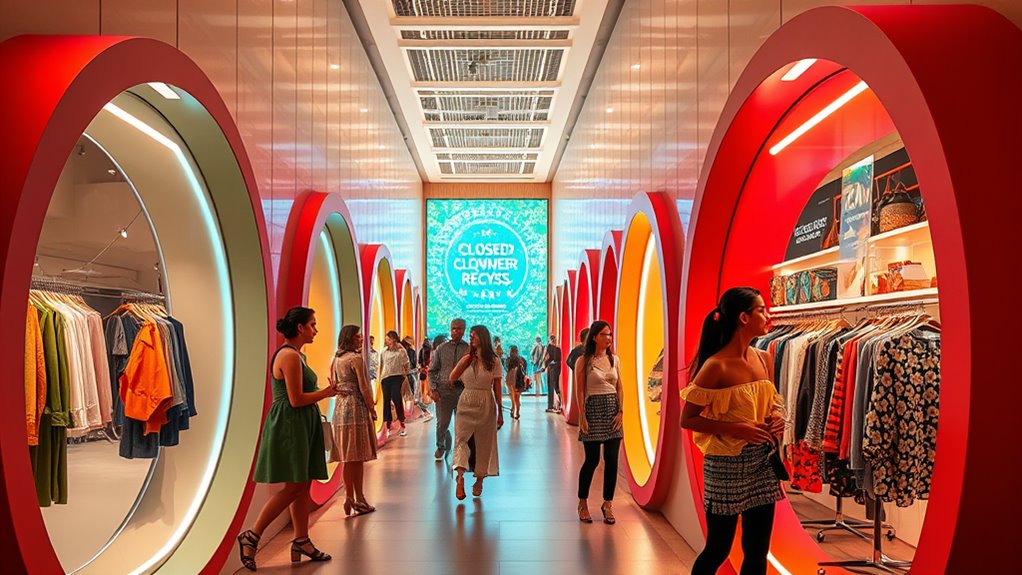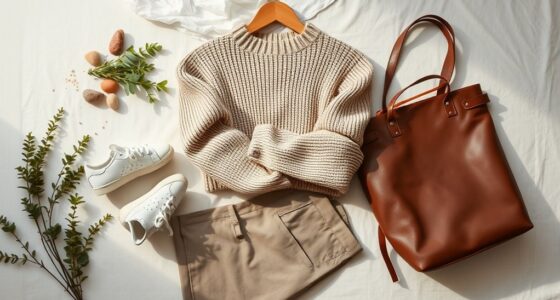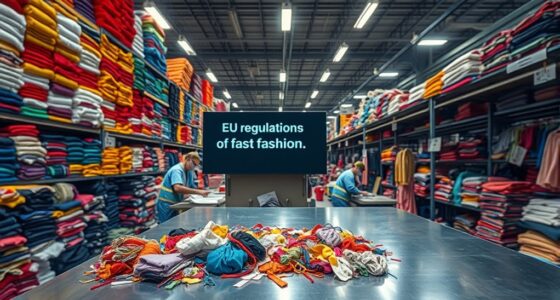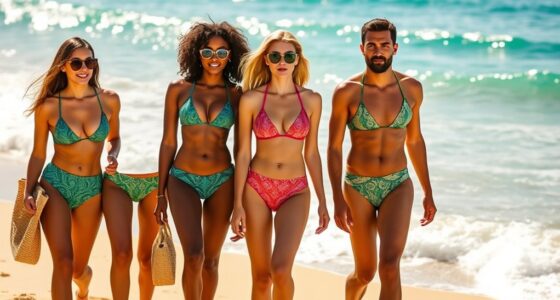By 2025, you’ll see the fashion industry shift toward a circular system that closes the clothing loop. Sustainable dyeing methods, eco-friendly packaging, and resource-efficient practices will reduce environmental impact. Brands will be transparent about their practices, encouraging you to make ethical choices. You’ll be part of a movement that promotes high-quality, long-lasting garments, recycling, and reuse. Learn how these innovations are shaping responsible fashion and what role you can play next.
Key Takeaways
- By 2025, fashion brands will adopt fully sustainable dyeing methods, reducing water use and eliminating toxic chemicals.
- Eco-friendly, biodegradable packaging will replace plastics, supporting waste reduction and circular consumption.
- Consumers will participate in take-back and recycling programs, transforming old garments into new textiles through advanced technologies.
- Transparency about sustainable practices will build trust, empowering consumers to make ethical fashion choices.
- The industry will shift to a closed-loop system, emphasizing durability, reuse, and resource efficiency for a more responsible fashion future.
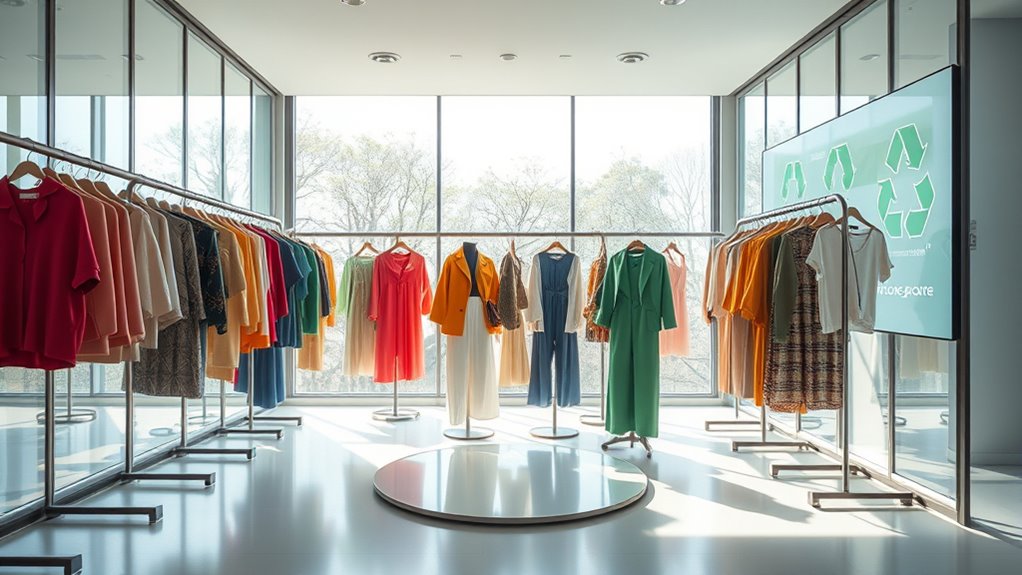
By 2025, circular fashion has become a mainstream movement that transforms how we produce, consume, and dispose of clothing. You’re now part of a system that prioritizes sustainability, where every piece of clothing is designed with its entire lifecycle in mind. One of the most significant shifts is the widespread adoption of sustainable dyeing techniques. Traditional dyeing processes use vast amounts of water and harmful chemicals, contributing to pollution and waste. Today, brands are embracing eco-friendly dyeing methods, such as plant-based dyes, waterless dyeing technologies, and natural pigments. These innovations drastically reduce water consumption and eliminate toxic chemicals, making fashion less damaging to the environment. When you shop or wear clothes, you can feel confident knowing they come from brands committed to reducing their ecological footprint through sustainable dyeing.
Alongside this, eco-friendly packaging plays an instrumental role in closing the loop on clothing. No longer do you see excessive plastic or non-biodegradable materials used for shipping and retail displays. Instead, brands are adopting biodegradable, recycled, or compostable packaging solutions. Imagine opening your new outfit and knowing that the packaging will break down naturally without polluting the environment. This shift not only reduces waste but also encourages you to be mindful of your consumption habits. When you receive clothing that’s packaged responsibly, it reinforces the idea that fashion can be sustainable from the moment it leaves the factory to when it arrives at your door.
These advancements in sustainable dyeing and eco friendly packaging are part of a larger movement toward circularity. You’re encouraged to buy less but better, opting for high-quality garments designed to last longer and be reused or recycled. Many brands now offer take-back programs, where you can return worn-out clothing for recycling or refurbishment. This keeps textiles in use longer and prevents unnecessary waste. Additionally, innovations like fabric recycling technologies enable old garments to be transformed into new textiles, completing the circle. You’re no longer just a consumer; you’re an active participant in a system that values resource efficiency and waste reduction. Moreover, integrating AI-powered recycling technologies can optimize sorting and processing, making recycling more efficient and effective.
In this new era, transparency is key. Brands openly share their sustainable practices, from eco-friendly dyeing processes to packaging choices. As a conscious consumer, you have access to information that guides you toward ethical options. This movement toward circular fashion isn’t just about trendy sustainability claims; it’s about fundamentally changing the way clothing is made, used, and discarded. By 2025, you’re part of a community that’s making fashion more sustainable, innovative, and responsible—transforming a linear system into a closed loop that benefits both the planet and future generations.
Frequently Asked Questions
How Will Circular Fashion Impact Global Garment Production Costs?
Circular fashion will likely reduce your garment production costs by promoting cost reduction through more efficient resource use and waste minimization. It also enhances supply chain resilience by encouraging local sourcing and recycling, which can lower dependency on raw material imports. As a result, you may see lower costs over time, alongside a more sustainable and adaptable production process that benefits both your business and the environment.
What New Materials Will Dominate Sustainable Clothing by 2025?
You’ll likely see biodegradable fibers and regenerative textiles dominate sustainable clothing by 2025. Some experts believe these materials can truly transform the industry, reducing waste and environmental impact. Biodegradable fibers break down naturally, while regenerative textiles, made from sustainably farmed crops or recycled materials, promote ecosystem health. As demand grows, these innovative fabrics will become standard, helping you wear stylish, eco-friendly clothes that support a healthier planet.
How Will Consumer Behavior Shift Toward Circular Fashion?
You’ll likely notice your consumer mindset shifting toward sustainability, making you more conscious of your purchasing habits. You’ll prefer brands that promote circular fashion, emphasizing durability, reuse, and recycling. As awareness grows, you’ll choose clothing that can be easily repaired or repurposed, reducing waste. This shift will encourage a more responsible approach to fashion, where your habits support a closed-loop system, helping to close the sustainability gap by 2025.
What Are the Biggest Challenges in Recycling Complex Textiles?
The biggest challenge in recycling complex textiles lies in fiber separation. You’ll find that unraveling blended fibers is tricky, often leading to fiber loss or contamination. Chemical recycling offers hope, breaking down fibers to their raw materials, but it’s expensive and not yet scalable. As you push for circularity, overcoming these hurdles is essential to truly close the loop and make recycling feasible for all textile types.
How Will Circular Practices Influence Fashion Industry Employment?
Circular practices will considerably boost fashion industry employment by creating new job opportunities focused on sustainability, recycling, and innovative design. You’ll find yourself engaging in skill development as the industry adopts advanced recycling techniques and sustainable materials. This shift encourages you to learn new trades, take on roles in eco-friendly production, and support a circular economy, ultimately fostering a more dynamic and environmentally responsible fashion workforce.
Conclusion
By 2025, embracing circular fashion isn’t just a choice—it’s a revolution waiting to happen. As you wear, reuse, and recycle, you become part of a cycle that sustains both style and the planet. Imagine a world where every garment tells a story of renewal, turning waste into wonder. Isn’t it time you closed the loop and led the change? After all, fashion’s future is as endless as your impact.
